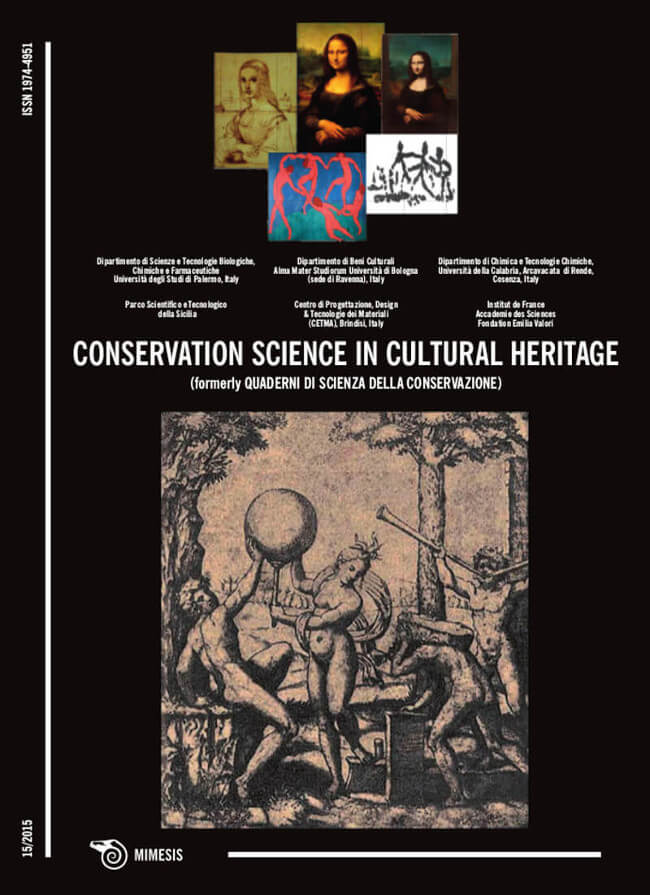The Scenography of Serpotta Stuccoes Revisited - Material and Form
DOI:
https://doi.org/10.6092/issn.1973-9494/6182Keywords:
philological reconstruction, 3D scanning technique, geometric processing, virtual reassemblyAbstract
The material that lies beneath the smooth shining surface of the stuccoes of the Serpotta family who used to work in Sicily from 1670 to 1730, has been thoroughly studied in previous papers, disclosing the deep, albeit empirical, knowledge of materials science that guided the artists in creating their masterpieces. In this work, attention is focused on the solid perspective and on the scenographic sculpture by Giacomo Serpotta, who is acknowledged as the leading exponent of the School. The study deals with some particular works of the artist, the “small-scaled plastic theatres”, so-called “teatrini”, which he made for the San Lorenzo Oratory in Palermo. On the basis of archival documents and previous analogical photogrammetric plotting, integrated with digital solutions and computer-based technologies, the study investigates and interprets the geometric-formal genesis of the examined works of art. Knowledge of the material composition of the stuccoes, along with the ability to accurately reproduce their shapes, give interesting possibilities to provide a complete reading of the works of art damaged by deterioration or theft.References
LO PRESTI, S., DI PAOLA. F., MINEO, S., 2011, Artificial stone in architecture: new techniques of intervention in the Utveggio Castle in Palermo, in “Conservation Science in Cultural Heritage”, Issue n. 11, pp. 195-217, ISSN 1973-9494, DOI: 10.6092/issn.1973-9494/2698.
LORUSSO S., SCHIPPA B. 2001, Metodologie scientifiche per lo studio dei beni culturali. Diagnosi e valutazione tecnico-economica, Bologna, Pitagora Editrice.
GARSTANG D., 1990, Giacomo Serpotta e gli stuccatori di Palermo, Ed. Sellerio, Palermo.
PARLAPIANO M., D’AGOSTINO F., MEGNA B., ERCOLI L., RIZZO G., 2005, Osservazioni sulla successione stratigrafica degli stucchi della scuola di Giacomo Serpotta a Palermo, in: AAVV. “Lo Stato dell’Arte” 3, Atti del III Congresso Nazionale dell’IGIIC, Palermo, Nardini ed. Firenze, pp. 460-465.
MEGNA B., RIZZO G., ERCOLI L., 2008, Characterization of stucco works by means of simultaneous thermal analysis, “XXX National Congress on Calorimetry and Thermal Analysis and Chemical Thermodynamics”, Pisa.
RIZZO G., ERCOLI L., MEGNA B., 2009, The skill in materials selection and processing at the Serpotta’s studio during the baroque period in Palermo, Cultural Heritage, Cairo, Egypt, pp. 1-5.
MONTAPERTO, M.L., 2013, Oratorio di San Lorenzo, Officine Tipografiche Aiello & Provenzano, Bagheria (PA).
PALAZZOTTO, P., 2004, Guida agli oratori. Confraternite, compagnie e congregazioni dal XVI al XIX secolo, “Kalós”, Palermo.
CARANDENTE, G., 1966. Giacomo Serpotta, Eri, Torino.
ARGAN, G.C., 1957, Il teatro plastico del Serpotta, in “Il Veltro”, n.7.
BASILE, E.,1981. Le sculture e gli stucchi di Giacomo Serpotta, Edizioni librarie siciliane, Palermo.
ARBACE, L., et al., 2012, Innovative uses of 3D digital technologies to assist the restoration of a fragmented terracotta statue, in “Journal of Cultural Heritage”, http://dx.doi.org/10.1016/j.culher.2012.06.008.
DI PAOLA, F., 2007, Il Complesso monumentale dello Spasimo. Lettura e analisi attraverso il rilievo, PhD Thesis, University of Palermo, PhD in Science of Representation and Survey.
GRUEN, A., REMONDINO, F., ZHANG, L., 2003, Image-based automated reconstruction of the great buddha of Bamiyan, Afghanistan, Comput. Vis. Pattern Recognit. Workshop 1, 13.
D’ALESSANDRO, M., PIZZURRO, P., 1989, La Prospettiva solida nella scultura scenografica del Serpotta. Rilievi fotogrammetrici con restituzione grafico-numerica, Arti grafiche Giordano, Palermo.
DE LUCA, L., 2011, La fotomodellazione architettonica. Rilievo, modellazione, rappresentazione di edifici a partire da fotografie, Dario Flaccovio Editore, Palermo.
LO BRUTTO M., MELI, P., 2012, Computer vision tools for 3D modeling in archaeology, “International Journal of Heritage in the Digital Era”, Volume 1, Supplement , pp. 1-6.
INZERILLO, L., SANTAGATI, C., DI PAOLA. F., 2013, Image-based modeling techniques for architectural heritage 3D digitalization: limits and potentialities, in “International Archives of the Photogrammetry, Remote Sensing and Spatial Information Sciences”, XL-5 (W2): pp. 550-560.
DI PAOLA, F., PEDONE, P., INZERILLO, I., SANTAGATI, C., Anamorphic Projection: Analogical/Digital Algorithms in “International Nexus Network Journal Architecture and Mathematics”, 16, Kim Williams Books, Turin. 2014. ISSN (online): 1590-5896, Springer, DOI: 10.1007/s00004-014-0225-5.
DI PAOLA, F., INZERILLO, L., 2011, Augmented reality. The case of Salinas Museum of Palermo. In “IX Forum internazionale di Studi Le Vie dei Mercanti: S.A.V.E. HeritageSafeguard of Architectural, Visual, Environmental Heritage”, La Scuola di Pitagora, Napoli.
SUMA, D., SAVINO, N., GALASSO, O., Services in support of promoting territorial tourism and culture: the living lab project EPULIA, in “Conservation Science in Cultural Heritage”, Issue n. 14, pp. 263-268, ISSN 1973-9494.
Downloads
Published
How to Cite
Issue
Section
License
Copyright (c) 2015 Salvatore Barba, Francesco Di Paola, Giovanni Rizzo
Copyrights and publishing rights of all the texts on this journal belong to the respective authors without restrictions. Authors grant the journal right of first publication.
This journal is licensed under a Creative Commons Attribution 4.0 International License (full legal code).
See also our Open Access Policy.






